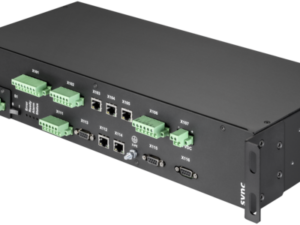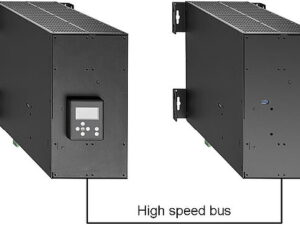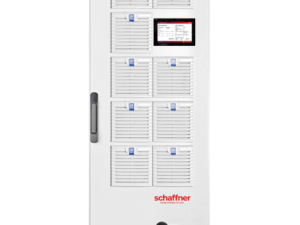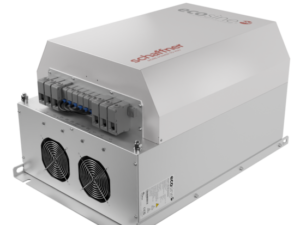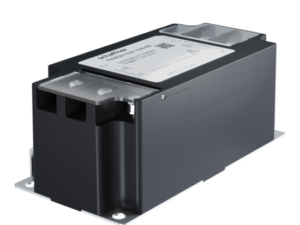If you’re designing electronic products, you need to install EMI filters to meet compliance requirements. But choosing the right filters involves many considerations beyond satisfying regulations. This article provides a basic explanation of EMI and shows you what to look for in choosing a filter.
Overview of Electromagnetic Interference (EMI)
What is EMI?
Electromagnetic interference (EMI) is noise interference caused by electromagnetic waves. There are two kinds of EMI: radiated and conducted.
- Radiated EMI is coupled through radio transmissions. Radiated noise from the air surrounding your device ends up in your circuitry.
- Conducted noise enters your circuitry by a different route-through the wires or connections leading into your circuitry.
Both kinds of EMI can degrade the performance of electrical equipment by inducing unwanted currents and voltages in the circuitry.
Causes of EMI in Industrial Environments:
- High-power electrical and electronic equipment: Devices such as Variable Frequency Drives (VFDs), motors, welding machines, and induction furnaces generate interference due to switching and large current transitions.
- Wiring and power cables: Unshielded or improperly routed wires can emit and pick up interference.
- Radio frequency transmitters: Devices such as radios, radars, and wireless communication equipment.
- Discharge phenomena: Arc discharge, surface discharge, and other similar effects.
Effects of EMI on Automation Systems:
Impact on Performance and Reliability:
- Measurement and control errors: Interference distorts measurement and control results, leading to faults in production processes.
- Reduced lifespan: EMI can damage electronic components, shortening device longevity.
- Operational disruptions: Interference causes system malfunctions, leading to downtime and financial losses.
Interference with Signals and Communication:
- Reduced speed and reliability: EMI lowers data transmission rates, increases error rates, and complicates communication between devices.
- Data loss: Interference can result in data loss, causing incorrect control decisions.
Potential Safety Hazards:
- System failures and accidents: EMI can trigger malfunctions in automated systems, leading to workplace accidents and equipment damage.
EMI Filter
What is an EMI Filter?

An EMI filter is an electronic component that suppresses EMI on a power or signal line by attenuating incoming signals at unwanted frequencies. Most electromagnetic noise is in the high frequency range. Thus, EMI filters often block high frequency signals from the tens of kilohertz to tens of megahertz, while allowing lower frequencies to pass through.
EMI filters can be used as a power line filter, e.g., to prevent noise from a switched-mode power supply from entering a device. The filters can also be used to stop noise generated within a piece of equipment from escaping into the surrounding environment and interfering with nearby electronics.
Types of EMI Filters
EMI filters come in various sizes, designs, shapes, and configurations, all intended to protect sensitive equipment from electrical noise. Below are some common classifications:
Passive EMI Filters: Passive EMI filters utilize passive components such as capacitors, resistors, transformers, and inductors to reduce electromagnetic interference. These filters do not generate a counteracting current but instead absorb unwanted energy, reducing voltage distortion in electronic systems.
Active EMI Filters: Active EMI filters use active electronic components such as amplifiers and complex circuits to generate a counteracting current that neutralizes interference. These filters create opposing currents to eliminate noise, effectively protecting sensitive electronic devices from interference signals.
LC, RC, and Pi Filters:

- LC Filter: Uses a combination of inductors (L) and capacitors (C) to filter out noise signals in electronic applications. These filters are highly effective in eliminating high-frequency interference.
- RC Filter: Uses capacitors and resistors to reduce noise. This type of filter is primarily used in low-frequency circuit applications.
- Pi Filter: Comprises a capacitor in the middle and two inductors on either side, forming a structure resembling the Greek letter Pi (π). Pi filters can eliminate various types of interference and are commonly used in high-power electronic applications.
Single-Phase and Three-Phase EMI Filters:
- Single-Phase EMI Filter: Used in single-phase power applications, these filters help reduce noise on AC power lines. They are commonly installed in household electrical appliances or small systems.
- Three-Phase EMI Filter: Designed for three-phase electrical systems, these filters help reduce noise in industrial applications or high-power systems such as inverters, motors, and industrial machinery. Three-phase filters can be categorized into Wye and Delta types, depending on the electrical circuit configuration of the system.
Structure of an EMI Filter

EMI filters (Electromagnetic Interference Filters) typically consist of key components such as capacitors, inductors, and circuit protection elements. Each component plays a crucial role in minimizing electromagnetic interference and ensuring system stability. Below are the main components of an EMI filter:
- Capacitors
Capacitors are essential components that divert electromagnetic interference away from the load and prevent it from entering the power supply. They help filter differential mode noise by creating a low-impedance path for noise currents while allowing regular current flow. - Inductors (Chokes)
Inductors prevent electromagnetic interference by introducing inductance, which resists sudden current changes. There are two common types of inductors in EMI filters:- Differential Mode Choke (DM choke): Filters interference between different conductors in the circuit, blocking differential mode noise.
- Common Mode Choke (CM choke): Reduces common mode currents, which are noise currents affecting all conductors in the circuit.
- Circuit Protection Components
These components safeguard the EMI filter from electrical faults such as overvoltage or overcurrent. Key protection elements include:- Fuse: Installed in series at the circuit input to protect against excessive current by automatically disconnecting in case of faults.
- Varistor: Provides overvoltage protection by absorbing surge energy and adjusting resistance to clamp excessive voltage.
- Inrush Current Limiting Resistor: Helps mitigate inrush current when AC voltage is initially applied to the circuit.
- Transient Voltage Suppressor (TVS): Protects circuits from voltage spikes caused by external factors, preventing damage to devices.
- Safety Isolation Capacitors (Y Capacitors)
Y capacitors are placed between the input and output to reduce common mode voltage interference, safeguarding downstream devices from unwanted voltage fluctuations. - Output Filtering
Output filtering components help reduce ripple voltage and stabilize power supply output, ensuring devices operate smoothly without interference.
With this structure, EMI filters effectively minimize electromagnetic interference, protect equipment, and ensure stable operation of electrical systems.
Important Specifications to Consider When Choosing an EMI Filter
- Rated voltage – Rated voltage refers to the maximum line voltage the filter can handle. It should be equal to or greater than the maximum input voltage to be supplied to the device being filtered. Filters can manage brief overvoltages above the rated level, and they are permitted by IEC standard 60639. But consistently exceeding the rated voltage can result in severe damage to the filter’s capacitors.
- Rated current – Rated current is the maximum allowable continuous operating current at the rated voltage and specified ambient temperature. The rated current of the filter should be equal to or higher than the maximum steady-state input current the device can draw. When the power is turned on, initial current flow may reach a peak current value larger than the steady-state current value. This is the inrush current. Filters can handle higher in-rush current, but if the rated current is exceeded for a longer duration, the filter can fail. The current overload characteristics of a filter describe its ability to withstand heat dissipated by the filter’s components when subjected to a higher-than-rated current.
- Rated frequency – The rated frequency, or the frequency at which a filter is designed to operate, is determined by the behavior of its capacitors. Typical filter frequencies are 50-60 Hz, and 400 Hz for military applications.
- Leakage current – During normal operation of electrical equipment, some current flows to Earth. This current, called leakage current, poses a potential safety risk to users and is therefore limited by product safety standards. An EMI filter can introduce additional leakage current to what already exists within your product. The amount of filter leakage is determined by the voltage on the conductor, the capacitance between the conductor and the ground, and the resistance between the conductor and the ground.
- Safety certifications – Leakage current is a crucial consideration for filters, especially for those installed in medical devices. Safety standards you should review include IEC 62368-1 (2nd or 3rd edition) for information technology equipment, IEC 60601 for medical equipment, and EN 55014 for appliances. Keep compliance requirements for your device top-of-mind when reading filter datasheets.
- Insertion loss – Insertion loss, one of the most important parameters in selecting an EMI filter, is the measure of the filter’s ability to reduce a given signal level. Also known as attenuation, insertion loss is the ratio of the signal at the input of the filter to the signal at its output, as expressed in decibels.
- Number of stages – An EMI filter may have one, two, or three stages. A single-stage filter has one circuit. If the circuit is repeated it becomes a dual-stage filter; if tripled, it becomes a three-stage filter. Single-stage filters are useful in AC/DC power supplies, small motor drives, office equipment, and other systems running on single-phase AC power. Devices running on three-phase AC power require an EMI filter for each of the three phase lines and a fourth for the neutral line.
- Size and structure – EMI filters come in many different sizes, shapes, and weights, which are determined by the filter’s passive components. For example, the selection and assembly of capacitors within the filter are key drivers of the overall physical structure of a filter.
- Common-mode (asymmetrical) versus differential-mode (symmetrical) currents – There is a significant difference between asymmetrical and symmetrical currents. Each mode produces a different type of noise, making this variable a key filter parameter.
- Operating environment – The enemy of all electrical and electronic equipment is excessive heat. The operating environment is the temperature range in which the filter can be safely operated. Filters can be rated for 40 C and 50 C, and can derate up to 100 C, or up to the maximum capacity of the filter. Using the filter at a temperature outside its operating range can severely damage the components.
- EMC certifications – Radiated and conducted emissions and immunity standards in electronic devices are regulated by national agencies, such as the FCC in the U.S., the ISED in Canada, and the IEC and CENELEC in Europe. Filters are typically designed to attenuate noise and interference signals in the frequency range from 150 kHz to 30 MHz, which meets most compliance standards.
- Dielectric strength – Dielectric testing, sometimes referred to as Hi-Pot testing, demonstrates the ability of the filter capacitors to handle higher-than-rated voltage. Designers of high-potential voltage applications should contact the filter manufacturer to ensure that the filter meets their requirements. Manufacturers can often modify their filters to meet special conditions. You should be aware that repeated high-voltage testing stresses a filter’s capacitors and can shorten their lifetime, so it’s advisable to keep the number of tests to a minimum.
Operating Principle of EMI Filters

EMI (Electromagnetic Interference) filters operate on the principle of minimizing or eliminating electromagnetic interference (EMI) in electrical signals. EMI can disrupt the operation of electronic devices, affect signal quality, and reduce performance. EMI filters help protect systems from electromagnetic interference by reducing the level of noise transmitted through electronic components.
The working process of an EMI filter can be described in the following steps:
-
Receiving Noise Signals: The EMI filter receives interference signals from the EMI source (electromagnetic noise) through the conductive paths into the device.
-
Noise Filtering:
- The EMI filter primarily operates using components such as capacitors and inductors.
- Capacitors: Redirect interference signals out of the circuit, helping to reduce high-frequency noise (differential mode noise) entering the device.
- Inductors: Block or mitigate low-frequency noise (common mode noise), preventing interference currents from penetrating the circuit.
- Cutoff Frequency: At a specific cutoff frequency, the EMI filter effectively reduces interference signals, allowing desired signals to pass while eliminating noise.
-
Circuit Protection: EMI filters may include protective components such as fuses or varistors, safeguarding devices from overcurrent or overvoltage conditions.
-
Ensuring Signal Quality: Once the noise is reduced, a clean signal continues to pass through the system without negatively affecting the performance of the device.
Benefits of EMI Filters
EMI (Electromagnetic Interference) filters provide several essential benefits in protecting and optimizing the performance of electronic devices. Below are the key advantages of using EMI filters:
Protecting electronic devices from interference: EMI filters safeguard electronic devices from conducted and radiated interference, preventing damage and operational failures. Using EMI filters is crucial to ensure stable and long-lasting device performance.
Compliance with safety regulations and standards: EMI filters help electronic devices comply with EMC (Electromagnetic Compatibility) regulations and safety standards, which is particularly important in various industries. This compliance helps avoid fines, penalties, and operational suspension due to EMI regulation violations.
Enhancing system reliability: EMI filters play a crucial role in maintaining the continuous operation of electronic systems by preventing failures and interference from external sources. This contributes to reduced maintenance costs, repairs, and extended device lifespan.
Long-term cost savings: Using EMI filters minimizes issues related to high-frequency interference, leading to cost savings in maintenance and repairs. Additionally, EMI filters help systems operate more stably, reducing the risk of operational failures.
Ensuring compliance with EMC plans: EMI filters are a vital component in EMC planning, ensuring electronic products meet EMC testing and certification requirements. This enables laboratories and manufacturers to provide accurate and reliable data while protecting devices from electromagnetic interference.
Disadvantages of EMI Filters
- Signal attenuation: May affect high-frequency signals, reducing system efficiency.
- Increased production costs: Requires additional components such as inductors and capacitors, increasing product costs.
- Takes up more space in devices: Especially for high-power or three-phase filters, posing challenges in circuit design.
- Increased energy losses: Internal resistance of inductors and capacitor losses reduce system efficiency.
- Requires proper selection and installation: Incorrect selection may render the filter ineffective or cause crosstalk between components.
- Needs regular maintenance and inspection: Performance may degrade over time due to temperature, humidity, and external factors.
Differences Between EMI and EMC Filters

- EMI (Electromagnetic Interference): Refers to the phenomenon where electromagnetic fields or magnetic fields cause unwanted interference in the operation of electronic devices.
- EMC (Electromagnetic Compatibility): The ability of a device or system to function properly in an electromagnetic environment without causing or being affected by interference.
Main Differences:
- EMI is interference, whereas EMC refers to the ability to resist or be compatible with interference.
- EMI filters are devices used to reduce or eliminate electromagnetic interference (EMI), contributing to ensuring EMC for devices or systems.
Simply put, EMC is the goal (electromagnetic compatibility), while EMI filters are one of the tools (means) to achieve that goal.
Applications of EMI Filters
EMI filters are widely used in various fields, including:
Consumer Electronics
- Power Supply: EMI filters are used in power supplies to reduce grid-induced noise and protect electronic devices from interference and voltage fluctuations.
- Adapters: Reduce interference from adapters and protect devices from harmful noise effects.
- UPS (Uninterruptible Power Supply): Filters noise to ensure UPS operates stably and provides clean power to critical devices.
- SMPS (Switching Mode Power Supply): Reduces noise generated by SMPS, protecting other devices in the system.
Industrial Applications
- Variable Frequency Drive (VFD): Reduces noise generated by VFDs, protecting other devices in the system and ensuring stable motor operation.
- Servo Drive: Filters interference to ensure accuracy in servo systems.
- PLC (Programmable Logic Controller): Protects PLCs from noise, ensuring precise control system operation.
- Automation Systems: Filters noise to ensure stable and reliable operation of automation system components.
Telecommunications & Medical Equipment
- Power Supplies: Filters noise to provide clean power for telecommunications and medical devices.
- Medical Equipment: Used in medical devices such as ECG machines and MRI scanners to prevent electromagnetic interference that could affect diagnostic accuracy.
- Communication Devices: In telecommunications systems, EMI filters help reduce noise in transmission and reception signals, improving call and data transmission quality.
Military & Aerospace Equipment: In military and aerospace applications, EMI filters ensure stable operation of electronic devices in harsh environments and reduce the risk of interference affecting system functionality.
How to Choose the Right EMI Filters
Before selecting an EMI filter, it is essential to thoroughly assess the electrical system’s requirements. Each type of EMI filter has unique characteristics regarding its operating frequency range and noise suppression method. Therefore, reviewing the filter’s technical datasheet is crucial, including information on insertion loss and signal attenuation between input and output, measured in decibels.
Conducted noise can be classified as either common-mode or differential-mode noise, each with distinct propagation mechanisms. When analyzing data, it is important to gather detailed information on both types of noise, determining the required attenuation level at each frequency to ensure the filter reduces noise below permissible levels. Additionally, similar tests should be conducted to evaluate radiated noise.
After collecting and analyzing data, compare it with system specifications such as voltage, current, operating temperature, insulation voltage, leakage current, and power supply type. The selected filter must meet these criteria without compromising system performance and stability.
Key Considerations for Installing EMI Filters
Several factors can impact the performance of an EMI filter, including:
Ambient Temperature
- Impact: High temperatures can degrade capacitor performance and other filter components, reducing noise suppression effectiveness.
- Solution: Choose a filter with an appropriate operating temperature range. Ensure proper ventilation around the filter to prevent overheating.
Grounding Method
- Impact: Improper grounding can create ground loops, increasing conducted noise and reducing filtering efficiency.
- Solution: Use low-impedance grounding wires and connect directly to the system’s common ground point. Follow safety grounding standards.
Wiring and Device Placement
- Impact: Signal and power cables placed too close together can cause crosstalk. Poor device placement can lead to unintended noise paths.
- Solution: Separate signal and power cables. Use shielded cables when necessary. Arrange devices to minimize noise source interference.
Noise Pathways in the System
- Impact: Noise can enter the system through various paths, including wiring, connectors, and device enclosures.
- Solution: Identify all potential noise pathways and implement appropriate noise reduction measures, such as EMI filters and grounding techniques.
If you replace an EMI filter, recheck both conducted and radiated noise to ensure compliance with standards. Schaffner can assist in evaluating EMI emissions and optimizing installation for peak performance.
Top EMI Filter Manufacturers:
Schaffner:
- A global company specializing in developing and manufacturing solutions for power quality and electromagnetic compatibility (EMC).
- Schaffner is renowned for high-quality EMI filters, offering a wide range of noise suppression solutions for various industrial and electronic applications.
- Schaffner’s products are highly regarded for reliability and performance, meeting stringent international standards.
TDK Electronics (EPCOS):
- TDK Electronics, under the EPCOS brand, is a leading supplier of electronic components, modules, and systems.
- They provide a broad range of high-performance EMI filters for applications ranging from household appliances to industrial systems.
- TDK Electronics is known for innovative solutions and superior product quality.
KEMET Corporation:
- KEMET is a global supplier of passive electronic components, including EMI filters.
- They offer diverse noise filtering solutions catering to various industries.
- KEMET is recognized for high-quality products and professional customer service.
Murata:
- Murata Manufacturing is a world-leading manufacturer of electronic components.
- They offer a wide range of compact, high-performance EMI filters suitable for mobile electronics and space-constrained applications.
- Murata is known for advanced technology and reliable product quality.
Astrodyne TDI:
- Astrodyne TDI specializes in designing and manufacturing power solutions and EMI filters.
- They provide both standard and customized EMI filters for industrial, medical, and military applications.
- Astrodyne TDI is known for delivering high-quality solutions that meet strict requirements.

 Tiếng Việt
Tiếng Việt

